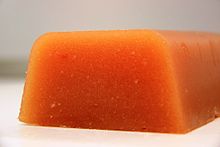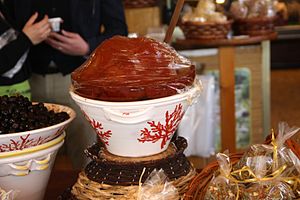 | |
| Type | Jelly |
|---|---|
| Main ingredients | Quince, sugar |


Quince cheese (also known as quince paste) is a sweet and tart, thick jelly made of the pulp of the quince fruit. It is a common confection in several countries.
In the Iberian Peninsula, this traditionally Mediterranean food is called ate or dulce de membrillo in Spanish, marmelada or doce de marmelo in Portuguese, marmelo in Galician, marmiellu in Asturian and codonyat in Catalan. It is a firm, sticky, sweet reddish hard paste made of the quince (Cydonia oblonga) fruit. It is also very popular in Hungary (as birsalmasajt), Portugal and Brazil (as marmelada), France (as pâte de coing in French and codonhat in Occitan, or cotignac in Orléans), Mexico, Colombia, Argentina, Uruguay, Paraguay and Chile (as dulce de membrillo), Italy (as cotognata), Croatia (as kotonjata or kitnikez), Serbia (as kitnikez), Peru (as machacado de membrillo), Israel (as ממבריו membrio), Turkey (as ayva peltesi) and Romania (as marmeladă de gutui).
History
The recipe is probably of ancient origin; the Roman cookbook of Apicius, a collection of Roman cookery recipes compiled in the late 4th or early 5th century AD, gives recipes for stewing quince with honey.
Historically, marmalade was made from quince. The English word "marmalade" comes from the Portuguese word marmelada, meaning "quince preparation" (and used to describe quince cheese or quince jam; "marmelo" = "quince"). Nowadays (in English), "A marmalade is a jellied fruit product which holds suspended within it all or part of the fruit pulp and the sliced peel. It is prepared from pulpy fruits, preferably those that contain pectin. Citrus fruits are especially desirable because of their flavor and pectin content."
Preparation
Quince cheese is prepared with quince fruits. The fruit is peeled and cored, and cooked with a teaspoon of water and from 500 to 1000 g sugar per kg of quince pulp, preferably in a pressure cooker, but it can also be left for longer (40 minutes–1 hour) in a regular pot, in this case with a little more water (which will then evaporate). It turns a light brick colour in the pressure cooker and on a regular pot, after a long cooking time, dark brick colour. After leaving it to set for a few days on earthenware/clay bowls (preferable), topped with parchment paper rounds, it becomes a relatively firm quince paste/cheese, dense enough to hold its shape. The taste is sweet but slightly astringent (depending on the amount of sugar used), and it is similar in consistency, flavor and use to guava cheese or guava paste.
Quince jelly is made with the skins and core, including pips, that were discarded when preparing quince cheese. They are cooked until halved in volume and the water is then sieved. For every 1000 ml water, 500 g sugar is added and the concoction is again boiled, until thread point is achieved.
Quince cheese is sold in squares or blocks, then cut into thin slices and spread over toasted bread or sandwiches, plain or with cheese, often served for breakfast or as a snack, with manchego, mató, Picón cheese (Spain), Serra da Estrela cheese or Queijo de Azeitão. It is also often used to stuff pastries.
Regional variations

In Spain, Uruguay, Argentina, Mexico, Chile, and Ecuador, the membrillo (quince) is cooked into a reddish gelatin-like block or firm reddish paste known as dulce de membrillo. Similar confections are made in Argentina, Brazil, and Uruguay by replacing quince with other ingredients, such as guavas in Brazil, squashes, apricots, and figs in Uruguay, and sweet potatoes in Argentina and Uruguay.
The pastafrola, a sweet tart common in Argentina, Uruguay, and Paraguay, is usually filled with quince paste. In Argentina and Uruguay, a slice of dulce de membrillo (quince cheese) eaten with a slice of soft cheese is considered the national dessert. In Argentina it is referred to as vigilante. In Uruguay it is known as Martín Fierro in reference to the folk character from the epic poem Martín Fierro by Argentinian author José Hernández.
In Brazil, a dessert known as Romeu e Julieta is made with Goiabada, guava paste with a similar consistency to quince cheese, and cheese. In May 2022, a variety of quince cheese known as Marmelada de Santa Luzia was recognized as an Immaterial Cultural Heritage of the Brazilian state of Goiás.
In the Philippines, it is known as membrilyo and is generally made from guava. It is usually served as a dessert during the Christmas Eve dinner (noche buena).
In French "quince paste" or pâte de coing is part of the Provence Christmas traditions and part of the thirteen desserts, which are the traditional dessert foods used in celebrating Christmas in the French region of Provence. In the city of Orléans, the cotignac is a speciality since middle age.
In Serbia, especially Vojvodina, all of Hungary, and continental Croatia, i.e., Slavonija quince cheese is an often prepared sweet and is named kitn(i)kes, derived from German "Quittenkäse".
Quince cheese, a New England specialty of the 18th century, required all-day boiling to achieve a solidified state, similar to the French cotignac.
In Hungary, quince cheese is called birsalmasajt, and is prepared with small amounts of lemon zest, cinnamon or cloves and often with peeled walnut inside. Péter Melius Juhász, the Hungarian botanist, mentioned quince cheese as early as 1578 as a fruit preparation with medical benefits.
In Vojvodina, it is sometimes prepared with addition of finely grated walnut, hazelnut or pumpkin seeds. Sometimes a certain amount of sugar would be replaced by an equal amount of linden honey.
See also
References
- Lisa & Tony Sierra. "Dulce de Membrillo (Quince Paste) Information". About. Archived from the original on 4 April 2015. Retrieved 9 December 2014.
- ^ "Vegetarians in Paradise/Quince History/Quince Nutrition/Quince Folklore/Quince Recipe". Vegparadise.com. Archived from the original on 11 February 2021. Retrieved 2 May 2022.
- "Orange Marmalade Taste Test - Cook's Illustrated". Cook's Illustrated. Archived from the original on 30 October 2019. Retrieved 9 December 2014.
- "marmalade | Etymology of marmalade by etymonline". www.etymonline.com.
- Farmers' Bulletin 1800 Home-made Jellies, Jams and Preserves Fanny Jerome Walker Yeatman, Mabel Clare Stienbarger Foods and Nutrition Division, Bureau of Home Economics. US Department of Agriculture May 1938. Slightly revised June 1945
- "Membrillo (quince cheese): How to...: Good Food Channel". Uktv.co.uk. Archived from the original on 23 October 2015. Retrieved 9 December 2014.
- Herbst, S. T.; Herbst, R. (2007). The New Food Lover's Companion: More Than 6,700 A-to-Z Entries Describe Foods, Cooking Techniques, Herbs, Spices, Desserts, Wines, and the Ingredients for Pleasurable Dining. Barron's cooking guide. Barron's Educational Series, Incorporated. ISBN 978-0-7641-3577-4. Retrieved 23 June 2017.
- "Postres uruguayos: el Martín Fierro". Todo Uruguay. 10 January 2015. Retrieved 24 April 2017.
- Souza, Vivian (2 August 2021). "De onde vem o que eu como: doce Romeu e Julieta tem nome inspirado em campanha publicitária com a Turma da Mônica" [Where what I eat comes from: Romeu e Julieta's name inspired by an advertising campaign with Turma da Mônica]. G1 (in Brazilian Portuguese). Retrieved 20 September 2023.
- "Diário Oficial publica lei que reconhece a marmelada de Santa Luzia como patrimônio goiano" [Official Gazette publishes law recognizing marmelada de Santa Luzia as Goiás heritage]. Assembleia Legislativa de Goiás (in Brazilian Portuguese). 3 May 2022. Retrieved 28 July 2024.
- "Membrillo". The Mother-in-Law's Kitchen. 2 April 2017.
- Alejandro, Reynaldo G. (2015). Food of the Philippines. Tuttle Publishing. p. 7. ISBN 9781462905454.
- "French Recipes – Traditional French Food and Desserts". About. Archived from the original on 6 April 2006. Retrieved 9 December 2014.
- "Christmas Traditions in Provence". Provenceweb.fr. Retrieved 9 December 2014.
- "Birsalmasajt". Chew.hu. Archived from the original on 22 December 2011. Retrieved 9 December 2014.
- "Birsalma sajt". Quali-t-uw.hu. Retrieved 9 December 2014.